

Edward Ka-Spel’s brilliance with The Legendary Pink Dots is to introduce us to isolated characters and then immerse us in their world-view through expansive and mysterious soundscapes. He begins with the most restricted, infinitesimal point of consciousness and then slowly expands it outward towards a state of ‘cosmic consciousness’ (to use the phrase of 1960s psychonauts). Musically, he often follows this template of expansion, with simple melody lines repeating and layering in increased complexity of texture. Much of the LPD’s music is an undertaking to help the listener (and perhaps composer) escape his/her own head. Lyrical phrases, musical motifs, album titles and themes recur across decades, but tonal shifts between albums are slow and subtle. Hopefully, The Legendary Dots Project, like the Residents and Sparks projects before, will provide the keen reader and listener with a giddy entry-point into the Legendary Pink Dots’ musical world. Fulfil the prophecy!
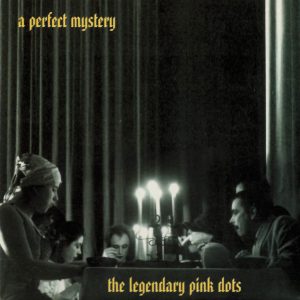
Tom: I’d say 2000 was as damned near a halcyon year I have experienced this far; add it to 1993, 2005, 2015 and 2019. Needless to say, we are talking personal rather than political… I was in the first to second year of College doing A Levels in History, Sociology and English Literature and it was mint. I was watching a vast quantity of films and listening to music and was enjoying meeting regularly with a fine group of friends, if not quite yet going out for drinks and all. This album was apparently released on 23 May.
On its cover, A Perfect Mystery has a monochrome photograph with five or so humans, most of their faces visible, gathered around a table with candles at the centre. All are looking down, reverentially, saying their prayers. The expressions seem serious and grave. The centremost man has his hand up, perhaps as part of some sort of religious gesture.
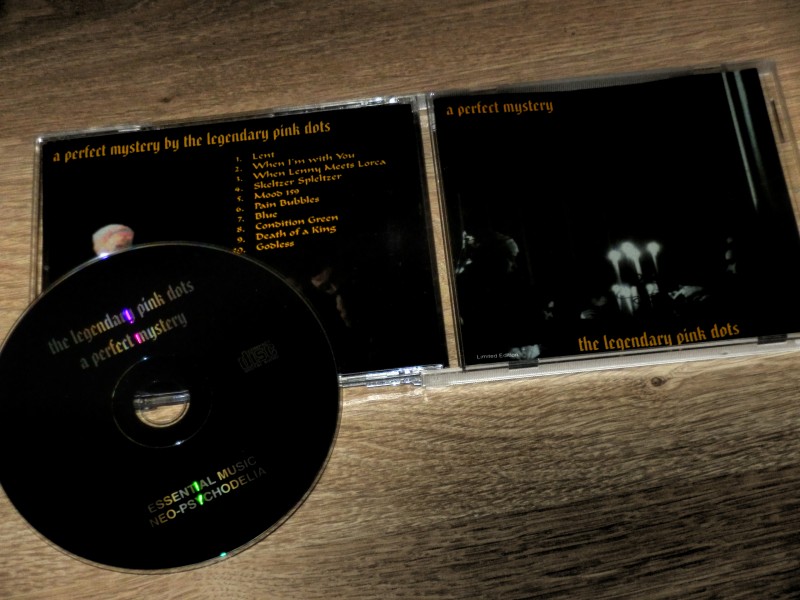
-
‘Lent’ opens with a sustained drone. “In your name…” infers another questioning of religion. This has a gravity that sits with the album cover, but also a sense of desperation, “our crosses rotting in the rain” as they wait. The production seems a tad perfunctory, not quite juxtaposing all the elements to their advantage. There are doubting horns and a lengthy lead electric guitar part. On first listen, I didn’t quite feel this earns its over-8 minutes of length, and it isn’t quite in the Maria Dimension, but it grows on you and is somewhat beguiling.
-
‘When I’m With You’ is about half the length. “Caesar lives, it’s 1939…” Watching the Christians fall in the water. St. Paul sponsors a TV channel. “Are you playing me?” is the repeated interrogative, as a surely minor-key melody unfurls. Baghdad and Casablanca… All Souls’ Night, last bus flies to Brighton… The music feels oddly like a certain kind of late-era ABBA song, even more gloom-drenched. Again, the music is strong, but the production seems limited and a bit constraining to the overall effect.
-
‘When Lenny Meets Lorca’ feels like the closest the LPDs have come to the feel of the inimitable Sparks. This has a far more catchy, presumably major-key melody, in comparison to the opening brace. It is also unusually direct in how Ka-Spel uses exophoric references to specific historical people: presumably the comedian Lenny Bruce (1925-1966) and the poet and dramatist Federico García Lorca (1898-1936) who died in Granada while fighting for the anti-fascist cause in the Spanish Civil War. This has flute and vivid psychedelic guitar, and an art-pop sound paralleling Brian Eno or Godley and Creme. A really tremendous upsurge in quality. The languid eccentricity of the music matches the lyric: “they walk on the water, they walk on the water…”
-
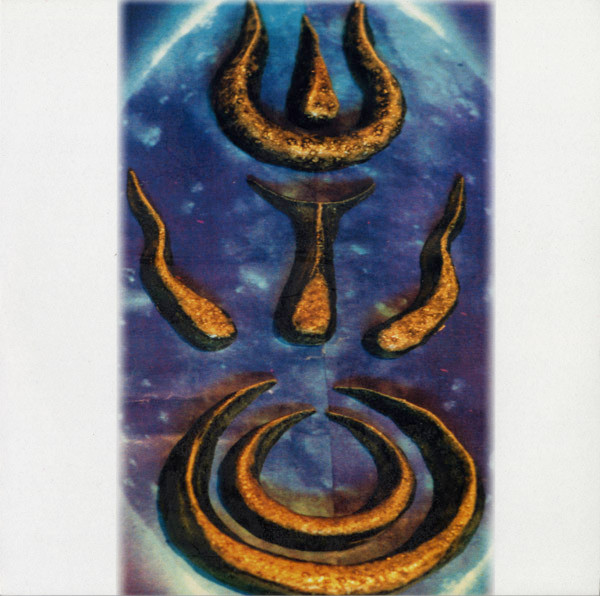
Artwork from the vinyl version by Nienke Poiesz. ‘Skelter Speltzer’ continues A Perfect Mystery’s upturn. A slower, shaggy dog tale with woozy, drunken sounding violins toying with Portsmouth Sinfonia-like messthetics. There is even, to my ears anyway, a superficial hint of North East English folk musician Alex Glasgow’s great ‘As Soon As This Pub Closes‘, but even more of a Syd Barrett feel, especially to EKS’s elongated vowels in “we sliiiiii-iiiiide…” A more chilled variant on ‘Fifteen Flies in the Marmalade‘, with that oddly English preoccupation with insects and a giddy nursery vibe.
-
‘Mood 159’ seems a rejoinder to dulling ‘freedom’ of 1990s individualism and consumerist capitalism: the other extreme to that of organised religion instilling obedience. In Can’t Get You Out Of My Head (2021), documentarian Adam Curtis discerns how there was, post-Cold War a disconnect, a lack of political representation amid politicians giving up on public service, simply hiding behind the complexity of global market capitalism while doing little. “We are come mail order”, Ka-Spel sings. This all led, as Curtis explains, to resurgent nationalism in Russia, in England, or indeed the smokescreen of Maoism in China… The void of modernism has been filled by nostalgic tales, first and foremost. Curtis highlights Putin’s counter-countercultural co-option of the Night Wolves biker gang as a paramilitary and propagandist arm of the regime, to persuade the young and to assist in invading Ukraine the first time. They are a deeply homophobic motorcycle club. “Has no heart, no borders” is a very interesting line; suggests that it isn’t simply nostalgic nationalism to question globalised capitalism. I’m not suggesting Ka-Spel is a Blue Labour acolyte of Messrs Rutherford and Glasman, far from it… But… Well, this is one of the most interesting songs in the LPD oeuvre to dig into, ideologically. Impressive electronic oddities after the 4-minute mark too.
-
‘Pain Bubbles’ grows into an eight and a half minute Godzilla of inexorable Goth space rock. The minor-key progression seems archetypal of a certain type of Dots song. The lyrics are absurd and fatalistic; not intervening, surrendering to chance when it is even clear that the chance is that she is going to die!
-
‘Blue’ is over 7 minutes of similarly dank, but slower gloom. This has a hazy, more relaxed musical accompaniment to a lyric of a lost love and paranoia about being taken to “the blue room”. Reminds me vaguely of Passengers’s 1995 song crossed with the Black Lodge in Twin Peaks (1990–1991). There is the desire to recall that they “shared” and “cared”, but it seems as if this is encoded with doubt. Slight hints of Pink Floyd about the languid music.
-
‘Condition Green’ seems more major-key, if delicately poised. In of those occasional acoustic guitar-led Dots tracks, Ka-Spel has a desperation to “keep you alive”, which may evoke God given later references. The title of the song points towards the planet, and the occasional ecocentric side of the Dots. But this is actually really a bedside melodrama. A solid, doughty song, almost Billy Bragg type guitar strumming, but evidently with more surreal psychedelia and a fatalistic surrender to God’s will vying with a desperation to save what I am taking to be a love’s life. Even if it means shipping a new heart from Zanzibar…
-
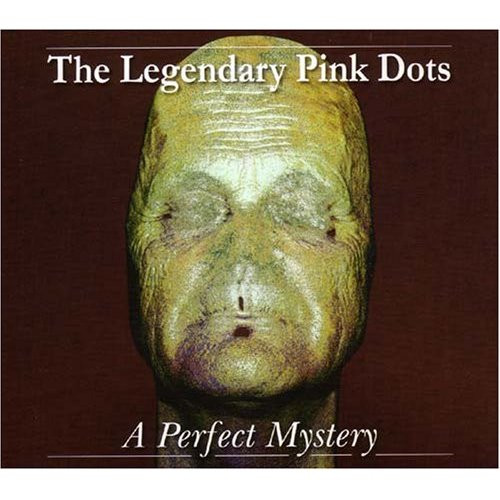
Alt cover with art by Zdzisław Beksiński. ‘Death of a King’ returns to long form, exceeding 6 minutes and is one of the unquestionable standouts on A Perfect Mystery. There is a sedate, compressed-sounding tabla rhythm, and a gorgeous melancholy violin-led melody. “We’ve lost the King, but not his face.” Public emoting is “demanded”. Martjin de Kleer’s violin and The Silverman’s synth parts intertwine in an archaic courtly dance of illegitimacy. There is a deliberate queasiness about the cultish chants of “LONG LIVE THE KING!” that stretch out beyond the 5-minute mark. The final percussion-less section has a grave stately quality which signifies as disturbing and intimidating. Of course, in autumn 2022 Blighty this evokes the death of Queen Elizabeth II and the strange staged public spectacle of her funeral and its TV broadcast. This is a MAJOR song, feeling medieval and yet also vast and timeless.
-
‘Godless’ is lengthiest of all on this album, at over 13 minutes. Skittering percussion, guitar repetitions and semi spoken vocals suggest ‘The Saucers Are Coming’. Sadly, this lacks that song’s deadpan cinematic grandeur and feels like an anti-climax after ‘Death of a King’. There are many ruminative atheist epics in the Dots’ oeuvre, and I’m unsure that this adds an awful lot. However, its “WERE YOU EVER THERE!?” interrogative is delivered with impeccable melodrama by Ka-Spel. And the details in the music are often excellent: nimble guitar, science fiction sound effects envelop you when listening on headphones. “A nothing that goes on forever…” While it’s not negligible, it still doesn’t somehow grab me as much in the context of listening to all this Dots music in order: I can’t help feeling it lacks something.
Lord knows what I’d have made of this album if I’d have heard it back in 2000. It was all about Black Box Recorder and, yes, Sarah Nixey for me then (mind you, I’d probably have liked it!) But it’s certainly revealed as a half-decent 2000 album in 2022; while not as consistent as Hallway of the Gods, this feels like a more sustained immersive album than Nemesis Online.
[Ed. If you want to skip ahead to Adam’s actual review, please jump down to the sentence “So, bearing all that in mind, let’s map out the coordinates!”, for which you can use the ‘Ctrl F’ function on your keyboard if available to you].
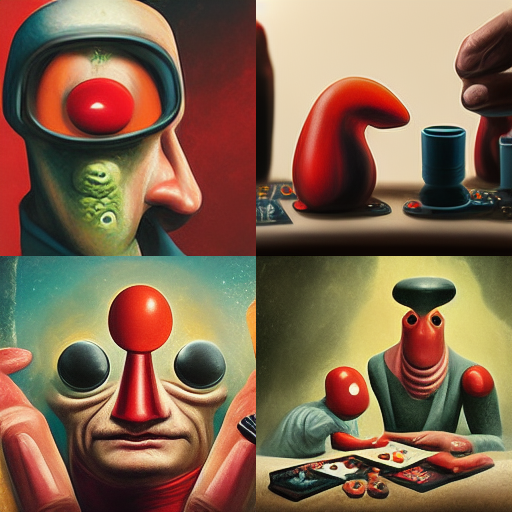
Adam: Writing these reviews, which can take Tom and myself a considerable amount of time, is quite a perverse, even pyrrhic, thing to do. When I originally pitched the idea for ‘The Legendary Pink Dots Project’ to Kittysneezes webmaster Matt Keeley some 10 years ago (a decade… “I grow old, I grow old, I shall wear the bottoms of my trousers rolled”) it was largely because I wanted to be in on the fun. Matt and his friends had made serious headway over just a couple of years at reviewing the entire discography of two of my favourite bands, Sparks and the Residents. I admired the maximalist, curatorial approach Matt was taking to this material, which I felt would be appropriate for the Dots, less well-known and less critically lauded than either the Residents or the Brothers Mael, but just as self-mythologising and, arguably, even more ambitious in their musical scope. While it was clear by 2012 that the blogosphere was dwindling and social media continuing its ascendency, I was nursing a frustration with myself for leaving my previous maximalist curatorial project of reviewing every Nicolas Cage film unfinished, and aware that my band (which had only ever half existed) was in a protracted process of falling apart. I was not, of course, anticipating that the project would take so long that, some 10 years into the future, I would only be half-way into the band’s discography. I wonder had Tom known this if he would have demurred when I ventured on Facebook to ask if any of my social media friends would join me on this exciting new venture…
While I have not had a Facebook account for three years now, social media remains the go-to means for fans eager to promote the media content they wish others to engage with while simultaneously signalling their own fandom. If the primary purpose of this blog were to simply expose more people to the music of the Dots, it would be better that I pay the £10 I occasionally pay to the band when Bandcamp Friday rolls around (and I remember) to instead gain a week’s worth of advertising for ‘The Legendary Pink Dots Facebook’ on social media.
So, would the purpose of writing these reviews be one of impressing myself upon the band, hoping to worm my way into their affections? Well, sad to say, but the days of keen fanzine producers being promoted to official merch table salespeople, seem to be long behind us. While Patrick Wright was very generous in gifting Tom and myself an interview to conclude the second series of our Repeater Radio podcast with, I have the faint impression that Ka-Spel himself isn’t especially fussed about having his every lyric dissected so that it can be left “pinned and wriggling on the wall” [ed. Eliot not Edward!] as might well be understood!

Only in the cases of the very worst art can a review eclipse the original in the enjoyment/ diversion/ healing/ catharsis/ transcendence [delete as applicable] provided to the audience. MST3K would not be effective if the team riffed on genuine cinematic masterpieces, which is why I have zero interest in listening to the RiffTrax take on Carnival of Souls (1962). I would always encourage listeners to go listen to the actual album The Maria Dimension (1991) rather than read our review of it or podcast on the same if it came down to only selecting one or ther other.
Plus, with so much content on the interview available (which can now be reconfigured, recombined and mashed-up endlessly by ChatGPT) and the likes of AllMusic now some thirty-years old, I’m aware that the words I’m writing are being sent out into a void from which they will be rescued by a handful of interested readers who could have spent their time reading on other worthwhile pursuits (endless Netflix shows tailored to one’s exact taste algorithms; impossibly long Steam libraries to play through; provocative Substack opinion pieces to read; hot takes all ready to be rejected or assimilated and regurgitated). I barely have time to stay on top of my work emails and spend time with my step-kids, let alone actually write these article, so it’s hard to imagine anyone having the time to read them! Kittysneezes’ WordPress stats calmly inform me that we have had 11,860 Pageviews over the last 30 days, 2% up over the preceding 30 days… which sounds really good to me… but then again, the average duration of these page views is 10 seconds, and I have no way of knowing how many of the eyes reading this text are those of bots. And since I’m not trying to get money out of this project or really convince anyone of anything, why am I interested in the attention economy anyway?
Apart from a tendency towards graphomania, I believe there are two primary reasons. Firstly, writing these reviews help me work out my own feelings about a Dots album, helping me to enjoy it more (and thus I hope this may be true for others). Secondly, I find the Dots’ output liberatory in a way which seems difficult or impossible to map onto any pre-given ideology; as such, plotting out some of the networks of contigencies that unfurl during a listening experience might point towards some kind of virtual parallel polis… or, at the very least, a little pocket of inner resistance or escape.
So, bearing all that in mind, let’s map out the coordinates!
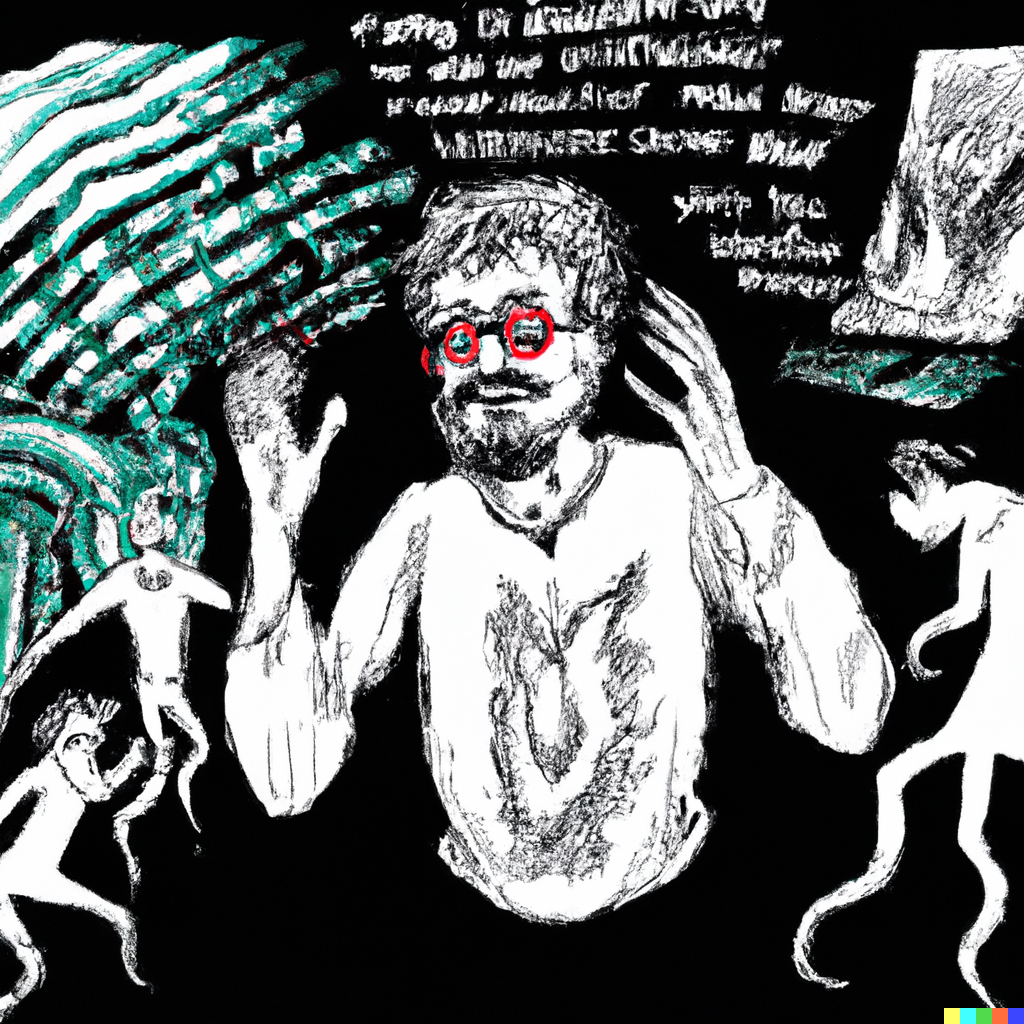
The album urges the listener to turn it up loud at its start, so quietly insidious is its start, with a buzzing that sounds like an electric discharge. When the drums eventually start, they are thin and vibratory like the percussion in an especially strung-out Bauhaus track. By the time van Hoorn enters with some sonorous parping, and Ka-Spel begins to sing, almost a third of the track has passed. The lyrics are from the point of view of a collective group of “starving volunteers”, self-flagellating Christians who “now stand before your floral gate to rend these rags and shout your name”. The lyrics actually strike me as a step down from those on The Maria Dimension (1991) due to Ka-Spel’s anti-Christianity being altogether too easily discernible beneath the narrators’ life-denying cries of renunciation. Unreliable narrators are most effective when you can imagine them believing their own bullshit, but here the congregants are as cartoonish as the head whacking monks in Monty Python and the Holy Grail (1975). Now, Ka-Spel has penned caricatured portraits of religious cranks previously and I haven’t complained! However, that is because the madness of the narrators of ‘The Blessing’ on Apparition (1982) or ‘I Am the Way, The Truth, The Light’ on Asylum (1985) reaches such a fever-pitch as to become hilarious. Here the tone is dour and portentious as it was for ‘The Grain Kings’ on The Maria Dimension, but without the intimations of mysticism that allowed the listener to understand how the characters from that album could get hooked on institutional religion. However, the music goes get spruced up in the latter half of the song, with van Hoorn’s parping grooves intermingling with some strung-out, countrified electric guitar! The song has become rather fun by the end of it, but it takes a while getting there.
The following song, ‘When I’m With You’, begins on a livelier note, with distorted guitar stabs and urgent violin, all coated in slick alt-pop production. It sounds utterly convincing as a potential college radio chart topper, yet elicits absolutely no emotional reaction from me. Tom reckons it’s the production that limits the effect achieved, but I actually think that (unusually!) Ka-Spel’s voice just doesn’t fit his own material here. ‘When I’m With You’ is something of a staple title, with artists as diverse as Sheriff, Chris Stapleton, Westlife and even Sparks having released a song by that name. These tracks are all romantic paeans to an idealised love object, and Edward’s lyrics here are no different… I think? The desired object of the narrator’s affections seems to have wandered off; when he calls them on their mobile phone, he receives the message that they’ve relocated. Even the moon seems wise to their wily game since it “looks down and laughs” while the narrator takes a bath with his soon to be departed lover. The kaleidoscopic snippets the listener is granted here does not give us much to go off, but the repeated line “Are you playing me?” is definitely emotionally-charged yet amorphous enough to be belted out in the chorus of a successful pop song! With the gloriously early ’80s saxophone here, a less wryly laconic singer than Ka-Spel is needed. Personally, I nominate Donna Summer circa 1981 fresh off the back of The Wanderer. Any of my concerns about the lack of emotional resonance in lyrics like “We eat pizzas by the pool… we watch the Christians sing then fall in quadro” (which I suspect are diaristic rather than allegorical) would be blasted away by Summer’s willingness to convincingly emote no matter the topic of the song! Does Ka-Spel simply have too much integrity to be a successful pop artist, or is he not crafty enough at synthesizing emotions for the consumption of the busy listener on the move? I don’t know, but I am convinced there is a cracking pop song buried here that another more commercial artist should try their hand at covering. Possibly, as with Becky Hill’s Christmas 2022 cover of Yazoo’s ‘Only You‘ for this year’s seasonal MacDonalds advert, the covering singer can even claim to have written the song about their grandpa! [This libelous claim was made by my mother about Ms. Hill upon relaying to me an interview that Ms. Hill gave upon the radio, but I’m not having anyone call my mother a liar].
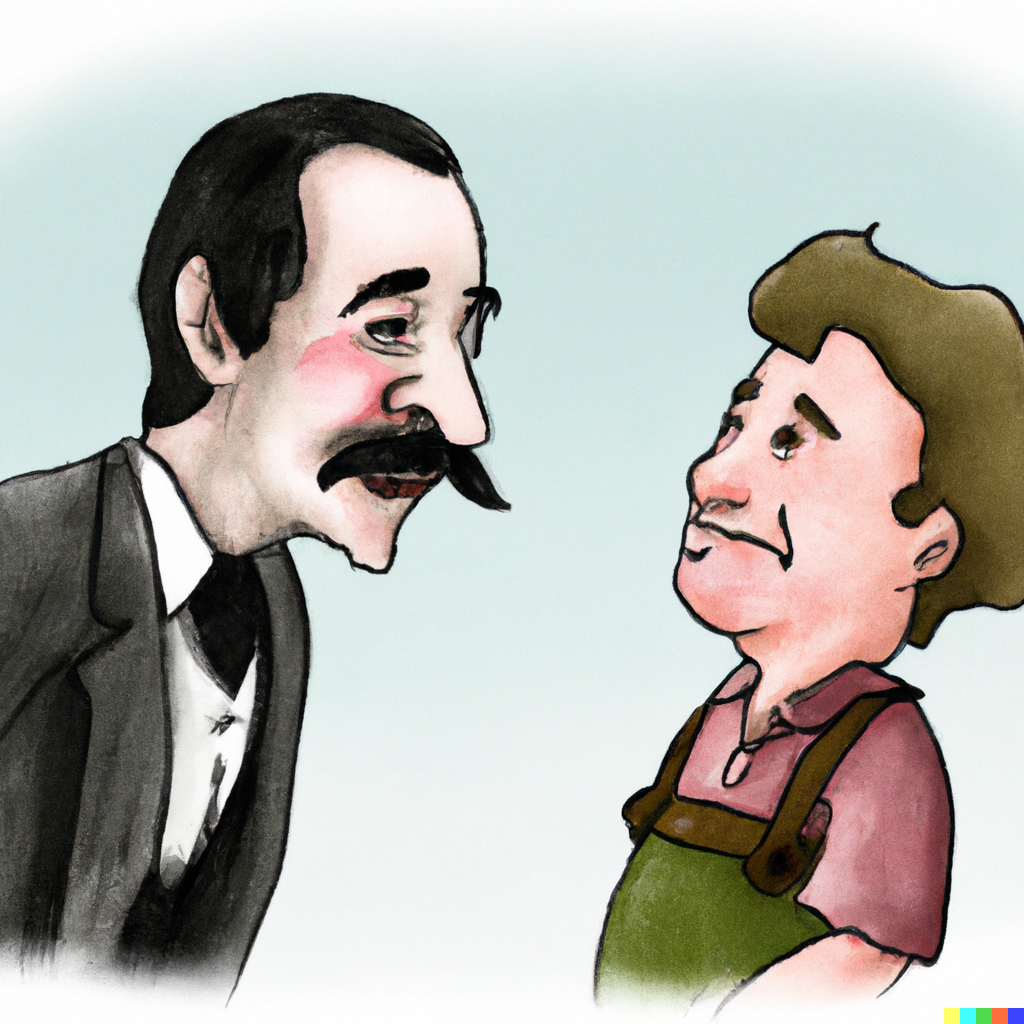
The next two tracks are a good deal of fun. I must admit that, since I am undergoing my year’s training to be an English teacher, when I read the title ‘When Lenny Meets Lorca’ I assumed it was not a reference to Lenny Bruce, but Lenny (sic.) from Steinbeck’s Of Mice and Men. The only reference to rabbits I could find in Lorca’s poetry was in ‘New York (Office and Denunciation)’ in which Lorca informs the reader that “Saint Ignatius of Loyola/ killed a little rabbit/ and still her lips moan/ by the church towers”. Like the Welsh farmer quoted by the Manic Street Preachers in ‘If You Tolerate This Your Children Will Be Next’, Lorca’s position here on rabbit killing is ambivalent at best. As such, it does seem more likely that Edward was imagining a conversation between Lorca and the counter-cultural comedic icon, rather than a fictional embodiment of the “inarticulate and powerful yearning of all men” [to quote Steinbeck]. However, the lyrics are obscure enough that it is difficult to tell for sure. Lines like “got dead-drunk porcupine mascara” recall, for me, the beatnik-aping poetry of Michael Stipe on R.E.M.’s New Adventures in Hi-Fi (1996) with his talk of “hash bars, cherry mash and tinfoil tiaras” on ‘E-Bow the Letter’ or “I look good in metallic sick wraparound blackout tease” on ‘Wake-Up Bomb’. I enjoy these startling noun pairings, but across an entire song, they don’t fully cohere for me. The coordinates are scattered; the lines blurry. Musically, the fuzzy guitar and playful melody are appealing; the 4/4 beat is easy to tap your foot along to; Edward’s vocals are soft and tuneful. A lovely trilling flute even comes it at the half-way mark! However, I don’t really know what to do with a pleasant ditty when it’s produced by the Dots! I want to scour it clean until it shines with some hidden gnostic meaning! But, as with the first two tracks, I feel myself bouncing back against a cartoon brick wall, nothing in my hands. Maybe I just need to learn to chill out and enjoy it…
Which, actually, I am able to do more with the next track, ‘Skeltzer Speltzer’, which is as languorously jaunty as a half-broken carousel. The music skits and scuds across its verses to a repeated, drawn-out refrain of “weeeee’ll slllllliiiiiiide” in each chorus, beneath which Martijn de Kleer plays his violin like a fiddle. Van Hoorn’s sax coming in over the top of this at the end of the song is //chef’s kiss//. I still intuitively feel that it does not add up to a whole bunch, but it is an enjoyably diverting, musically interesting song that (unexpectedly and presumably unintentionally) strongly recalls the music of faux-Victorian chamber rock trio Rasputina, who had released their sophomore How We Quit the Forest two years previous in 1998.

Next, ‘Mood 159’ enters the fray, walking sideways, like a misbegotten jazz crab! This is the kind of electro-junkyard malarky that I enjoy… a bit smoother and more low-key than on a Tom Waits or Už jsme doma record, but more sly and insidious for it. I’m not sure why this kind of ramshackle cacophany that spills over with lots of different sounds and noises (some flinty! some squelchy!) tends to do so much for me… thinking about the matter in vague, imprecise terms, it conjures images of a world less bound by the superego and physics than our own. The ultimately electronic (rather than analog/ organic) version of this that exists in my head is the parade sequence in Satoshi Kon’s Paprika (2006) as scored by Susumu Hirasawa, formerly of the Japanese progressive rock band Mandrake. The lyrics of ‘Mood 159’ suggest airborne flight over a crowd of people… not so much parading, but standing idle, with “burning eyes” that turn “to the East, tracing [a] beast that has no heart, no borders”. Again, the lyrics are gnomic and enigmatic, hard to get a hold on, though I love Tom’s reading that they are a “rejoinder” to the so-called freedom of ’90s individualistic consumer-capitalism in the wake of the fall of the Berlin Wall. The parade in Paprika imagines all the geegaws, toys and trinkets of Japanese consumer-capitalism [it is not clear whether the “East” in the lyrics is that of Asia or Eastern-Central Europe] as a monstrous embodiment of Japanese society’s collective infantile ID. I am writing this review at Christmas time so it is easy for me to imagine that the airborne figure derided by Ka-Spel’s narrator as “full of air”, pointing their finger in the dark, as a monstrous Santa Claws, pointing his fat finger at children to implore them to drink more Coca-Cola! Indeed, who else could the words of the album’s cryptic press release be describing but our great Old Norse God (turned consumerist icon) Santa Claws:
Power. The unutterable lust for power. How would it be if there was no shame attached to this trait? A belief in yourself as puppet master, shaping lives, moulding a world together that fits you like a glove; ultimately the certainty that only you exist and everyone and everything around you is merely a pliable illusion. The universe can only tolerate so much madness, and as the lust grew, he faded. And nobody forgave or honoured him for his actions because they couldn’t remember his name or his face. Deeds, events slipped into history, into mythology, into stories to scare children with, into nursery rhymes of which nobody could decipher the meanings…. Into almost nothing. Almost.

Side B of the album moves into more developed, proggier territory, which I think suits this period of the Dots where the emphasis was clearly on live performances with a full band, rather than on more conceptual, album-oriented songwriting. ‘Pain Bubbles’ is a majestic factory of guitar noise, a little hamstrung by claustrophobic production. Edward reflects that he has “some regrets about not capturing the enormity” of the track, which I can only imagine really soared when heard live. Van Hoorn’s playing is especially riveting, stirring inarticulable emotions in my gut. At heart, I think this is his album… and it is certainly the Dots album I would first recommend if you are foremost a saxophone enthusiast. The following track, ‘Blue’, is beautiful, with coiling guitar and some rather delicate vocal work from Edward. Phil’s electronic noises blanket the track in a tentative warmth, reflecting the lyrics of mutual solitude shared between lovers.
‘Condition Green’ begins with a clearly articulated strum (it’s rare that you can immediately distinguish a strumming pattern from a Dots song!) and builds up gently and tastefully. The lyrics are seemingly from the point of view of a person trying to keep a loved one alive against all odds. Whether this is delusional or not is unclear, but the yearning is palpable. By contast, ‘Death of a King’ sounds arch and ironic, a knowingly artificial hybrid of Hindustani classical music with European Medieval pageantry, heralding the arrival of a high-fantasy keyboard patch at its very end! Tom’s description of the piece is spot-on, though I think he was able to take it rather more seriously than I was.

The album proper ends with ‘Godless’, which is an atmospheric Krautrock-like piece set to a monologue about some kind of (super-)natural event that wrecks the walls and throws the cutlery to the ground, pitching the narrator into a fragment detached from time and space. It recalls the spoken word pieces on the previous albums, Hallway of the Gods (1997) and Nemesis Online (1998). The narrator screams out at an ontologically absent and emotionally indifferent universe, asking of a non-existent God, “Were you ever there?” This narrative actually helps to illuminate the obscure lyrics of the preceding (aforementioned) tracks that compose Side B, ‘Pain Bubbles’, ‘Blue’, ‘Condition Green’ and ‘Death of a King’, which can be rendered intelligible and moving if read as being from the point of view of a non-interventionalist and absent deity.
Thus, in ‘Pain Bubbles’ He hovers above a suffering woman, hanging around and feeding off her pain without actually changing her fate since, as He observes, “your destiny is all mine/ I’m not giving you an answer/ I’m just leaving you the time”. In ‘Condition Green’ He is now at a bedside, pulling the strings to decide whether the comatose patient on the bed [the same suffering woman as before?] will stay alive or die. In ‘Death of a King’ He reflects upon His role as the Big Daddy Other, now emasculated and humanised (in the role of Christ) yet ironically deified all the more for that.
Of course, I do not know whether this map I have sketched out with the obscure coordinates given me is complete hokum, but it is a meaningful map for me as a listener that has helped me navigate the dark waters of a somewhat impenetrable album. I hope this map I have provided helps one of you too!
—
On the Dots’ Bandcamp page for the album, ‘Premonition 25’ is also linked. It’s an especially creepy and hauntological offering, with over-layered whispering and some utterly ‘orrible sounds appearing out of the darkness. Give it a whirl creepy kids!